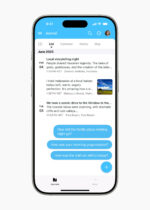Not long from now, in the coming weeks or months, the world will change yet again for millions of iOS users. iOS 6, which has now gone through multiple beta cycles, is nearing completion. Apple has promised “over 200 new features” and additions as of the company’s Worldwide Developers Conference in San Francisco this June, and the development tools have been downloaded by an ever-increasing number of developers.
The changes, as they’ve been stated, are somewhat monumental in scope.
Perhaps the most prevalent are a brand new focus on Siri, Facebook and Twitter in the upcoming operating system. iOS 6 seems to have opened up to allow Facebook and Twitter sharing from additional aspects of the operating system, including the App Store, Contacts and Calendar.
Meanwhile, Apple seems to have taken any and all criticism stated about Siri to heart. The new Siri, which received a fair amount of attention and focus at WWDC, is now capable of moving beyond its iOS 5 feature set of activating basic system functions and using assorted search engines to locate data, and can now home in on specific topics such as movies, sports, show times, game times and reviews.
Apple has tied its marquee technology in with popular feedback sites such as OpenTable, the Rotten Tomatoes movie review site, and Yelp to show users what to expect from the business they might be interested in. And, at long last, Siri will come to the iPad, albeit only for the third generation of the tablet, said the company.
Apple also announced that it has been working with car manufacturers such as Ford and Honda to bring “Eyes Free” integration with Siri. As such, Siri will be integrated with existing voice-control systems and steering-wheel buttons. While your iOS device’s screen won’t turn on in this mode (thus removing a possible distraction), Siri will still be fully functional and operative.
A new Maps client (reportedly powered by TomTom) within the betas shows Apple breaking away from certain Google services. The new application allows users to drop GPS pins as needed, use detailed 3D views of certain urban centers, retrieve turn-by-turn directions, find automatic reroutes in the event of missed turns, and print maps as needed.
These features accompany a slew of changes to the operating system that work to create a simpler, more efficient user experience as well as new choices for core applications. A new “Do Not Disturb” feature offers the user the ability to receive incoming messages that won’t activate the phone in any way, for when the user is in class, napping, or in a meeting, for example. Do Not Disturb allows for the creation of custom messages, and can also allow certain contacts to break through with their calls. It also pays attention to repeated calls and texts, determining if they indicate a possible emergency.
Finally, a new “Remind Me Later” feature pays attention to time and location-based callback reminders, defaulting to alerts in a user-specified timeframe or when you leave your current location (such as returning home, or getting to work).
The next few years of mobile devices will probably pave the way for an NFC (near-field communication) world in which your Android or iOS handset will store assorted information and can be used to pay for a wider variety of goods and services on the spot, thereby making your device a digital wallet of sorts. While it’s hard to say exactly how close iOS 6 will bring you to this world, Passbook, a new stock app in the iOS 6 betas, has been presented as a way to store information such as boarding passes, movie tickets, retail coupons, loyalty cards and others within the device.
A slew of tie-ins from vendors such as Starbucks and movie theater chains allow the user to go to a given retail location and scan their phone to receive goods or services. Users can also check the details of the service at hand, such as checking a coupon’s expiration date, where exactly their concert seats might be, or how much value is left on a coupon. The app is both time- and location-enabled, providing updates to the user as to whether they’re in the correct location to redeem their ticket or gift certificate.
Even at the end of the second beta, the features war between iOS 6 and Google’s upcoming incarnation of Android is still going strong. With the companies trading blows like boxers in the middle of a match, neither side showing signs of wearing down or giving in.
So how does this affect you when the iOS 6 beta cycles end, the final version hits golden master, and just about every iPhone from the 3GS on, every second- and third-generation iPad, and every iPod touch from the fourth generation on, migrate to the new OS in a short period of time? And, more importantly, just how crazy are you going to be in bringing your iOS apps up to date to take advantage of everything Apple is looking to incorporate into iOS 6?
The answers may be a bit more reassuring than you think.
“As with all major system updates that Apple did so far, apps are typically very compatible, but if you want to honor some of the changes for the benefit of your users, you’d need to adopt them. I expect one of the features in iOS 6 to make one aspect of my video editing app up to 10x faster than before,” said Markus Nigrin, President of Galactic Bits, a maker of photo-extraction tools for the iPhone and iPad.
When asked about the features he looked forward to in iOS, he added, “I can only answer that based on the official announcement of iOS 6 from Apple: iOS 6 is a careful overhaul of most of the functionality I love about iOS as a user. It tightens that functionality and brings it closer together, so the whole user experience from shopping for apps to taking pictures to using apps is improved. Under the hood, which I’m not allowed to talk about yet, we see some very nice improvements in terms of functionality and speed of certain functionality that will help us make better apps.”
Expectations and changes
If there’s good news to be had with the release of the new iOS, it’s this: While things are changing, there isn’t a major hurdle of the operating system that needs to be completely worked around and embraced by developers.
“It’s mostly compatible, not much work to update,” said Kevin Hurst, vice president of mobile product management for eBay. “This will be a bigger issue if Apple releases another device that has a different resolution screen.”
“I’d say iOS 5 was more about introducing new functionality while iOS 6 is more about bringing it together, applying the learnings on how users and developers used that functionality introduced with 5,” said Nigrin. “If the typical user uses a certain percentage of the core functionality of the device (let’s say taking pictures, reading e-mails, connecting to social networks, using maps, consuming music/movies, using apps), the integration in iOS 6 will offer those typical users more convenient gateways into doing more. For me, as a developer, this is very exciting. If Apple can guide the masses (not just the power users) to broaden the usage of their devices even more, that will trigger more people to look for more apps.”
“I think the hardest jump I remember was the jump to 4 when Multitasking was introduced,” said Bruce Morrison, owner of Man Up Time Studios, a game development company. “It required the most changes to ensure games background and resume properly. But the benefit to players was enormous, and it still wasn’t that hard.
“I think a lot of this comes down to what you do. Those of us who make games, we are kind of isolated from major OS changes,” he added. “The point of a game is to completely hide the OS from the user and immerse them in your world, even if just for 30 seconds. App makers need to embrace all the stylistic changes, new services, etc. Either way, Apple has the best engineers busting their [butts] to make iOS the best platform around. They are not going to screw it up by making it hard for developers to update into.”
Morrison said that in the new OS, he is most looking forward to the deeper Facebook integration. “The current single sign-on that Facebook offers is great, but knowing a user is logged in built into the OS, that’s killer,” he said. “It’s a universal identity that allows developers to create custom personalized accounts without the need to ask for e-mail addresses and other things players are reluctant to do. Also, buying an app from another app will be huge.”
“We are particularly excited about the possibilities in iOS 6’s Social Framework,” said eBay’s Hurst, referring to the generic APIs for accessing the top three major social networks with system-wide account authentication, Safari support for banners that deep link to applications, and Passbook.
In spite of the excitement around iOS 6’s anticipated features, there remained mixed views about the development tools offered for use.
“Xcode 3 was a pretty good environment, but Xcode 4 is simply horrible,” said Noel Llopis, independent game developer and founder of Snappy Touch, a game developer for iOS. “Apple did the typical rewrite and got so many things wrong. It reminds me of Visual Studio .NET when it came out. Xcode 4 is one of the main reasons I’m considering going more cross-platform, so I don’t have to use it on a daily basis.”
Others were more sympathetic to the tools on the table.
“The fact that we get preview versions as soon as they announce can’t be overstated and praised enough,” said Galactic Bits’ Nigrin. “The consensus in my Twitter network is that the tools can always be better and, yes, we like to complain, but overall the tools are much better than what you’d find somewhere else.”
“Really, it’s Apple’s documentation that makes it easy to ensure compatibility,” said Morrison. “Xcode is just Xcode at this point. You either embrace it or complain online. But really it’s a mature, solid platform.”
One of the most striking changes to be found in the iOS 6 announcements was Apple’s transition away from Google Maps to its own mapping service.
“I’m surprised it didn’t happen sooner,” said Morrison. “Apple’s never been one to rely on others. You see it with their hardware and software. I think Google should be worried; everyone is chipping away at them from all angles.”
“I wish those two would get their act together and find more common ground, but I can see why this is happening,” said Nigrin of the issues between the two industry giants. “As we know, it’s ‘not personal, just business.’ “
Focusing on the future
Perhaps the next logical questions are as follows: How will iOS 6 affect your company’s development cycle, and how approachable is it for the new developer/company looking to finally make inroads by writing their own iOS app?
“It’s about the same jump, not much work,” said Hurst when asked how much effort it might be to make eBay’s current iOS apps compatible with iOS 6.
“We think for most apps it will not be a huge amount of work; probably less than the [iOS] 4 to 5 transition, which had the big change of ARC (Automatic Reference Counting),” said Bill O’Donnell, chief architect at KAYAK, a travel services website. “The best thing about a new iOS version coming out is that you can start to be more aggressive about dropping support for older versions. So if your app supported iOS 3, 4 and 5 to this point, you might be able to say, ‘OK, 6 is out now, time to get away from iOS 3.’ And that can really move your technology base forward.”
Others see the upcoming OS and its impending features as a means of growing their business.
“From a marketing standpoint, there are a number of new upgrades that will benefit the app developer,” said Aaron Watkins, cofounder of Appency, a marketing group currently handling public relations for a client list of iOS app developers. “Deeper Facebook integration will make it much easier for consumers to share, and thus promote, content from within developers apps, and app store pages on iTunes will now have ‘Like’ buttons, giving a great new place for developers to attract consumers into their re-marketable social networks.”
Watkins then went on to describe how upcoming iOS 6 Safari features, such as “Smart App Banners,” can be embedded into websites and allow for one-click access to the App Store to purchase new apps.
“What remains to be seen is if any other major updates to the iTunes store component will come with iOS 6, as the iTunes software will need an update to handle the new Facebook-like feature,” said Watkins. “Anything Apple can do to increase app discovery will be a step in the right direction,” he added, noting Apple’s recent announcement of the upcoming Food & Drink category in iTunes.
“It’s been four years since Apple created such a tightly integrated user experience that people suddenly downloaded (and bought) apps en masse,” said Nigrin. “Many more than anybody would have expected. We tend to forget how extraordinary this was and start to take it for granted.
“But it isn’t. In fact, doing integration right is much harder than almost anything else. It isn’t about having Facebook integration or any given feature. It is all about how that integration is executed and how organic it feels for the user. Only the execution makes users actually use stuff.
“I feel iOS 6 is taking a lot of things to a next level there, and I’m super excited about it, because I understand how hard it is to get this right and I understand how much this might push the ecosystem forward. 25 billion apps downloaded? We have seen nothing yet!”
Maybe he’s right. Maybe 25 billion apps is only the tip of the iceberg.
We’ll find out in just a few short months.





